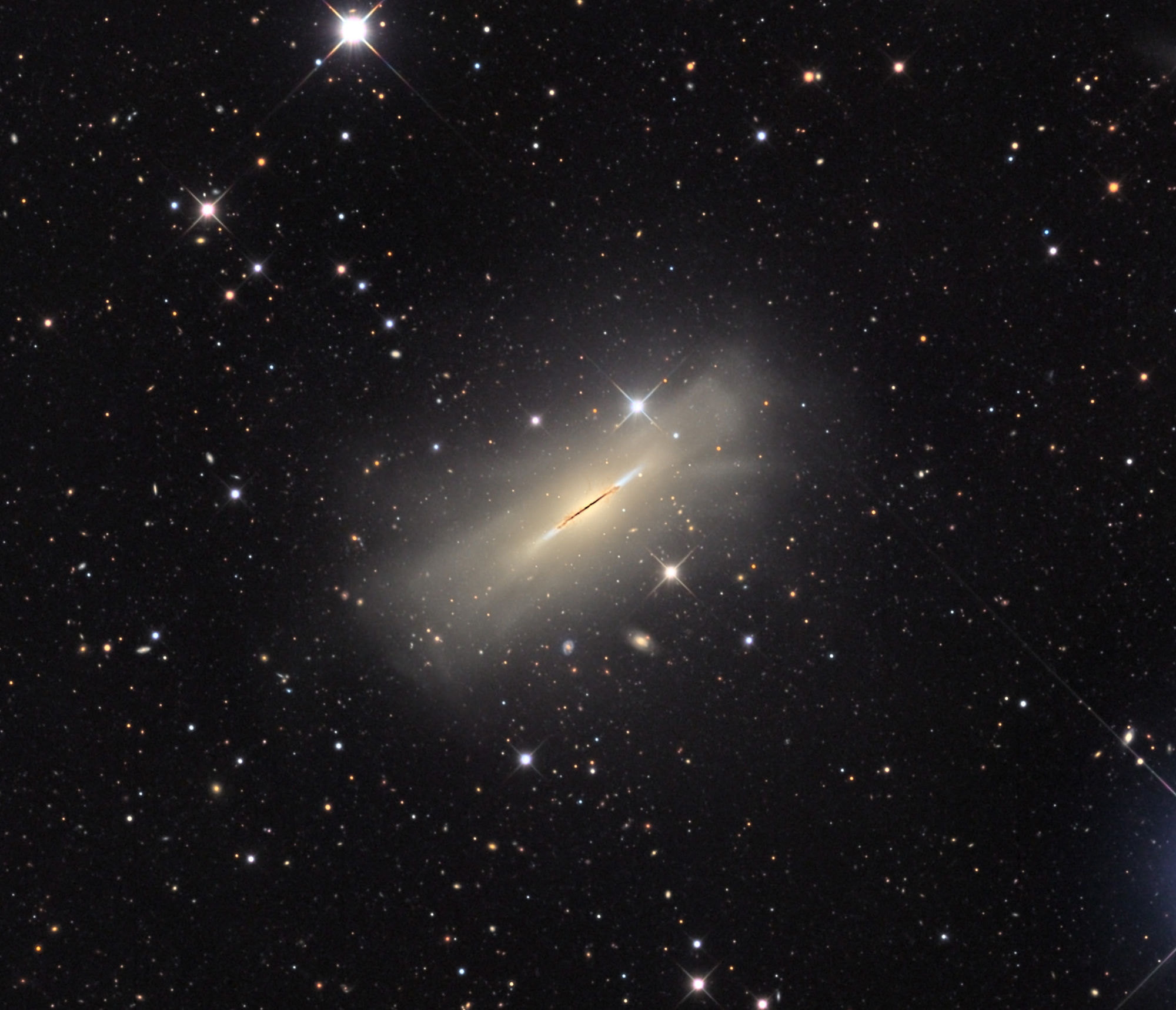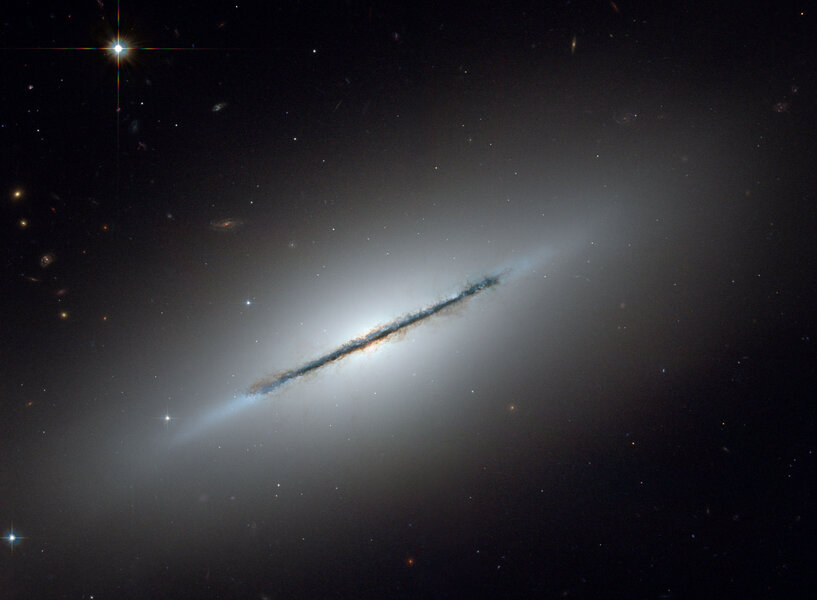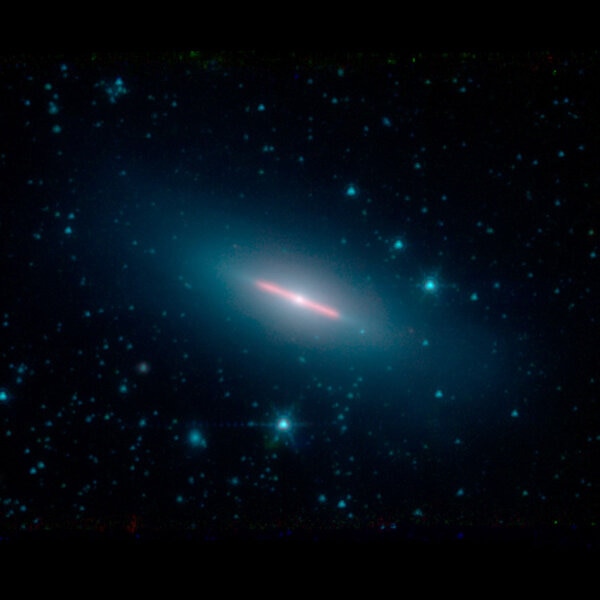Create a free profile to get unlimited access to exclusive videos, sweepstakes, and more!
Solving the riddle of the edge-on galaxy NGC 5866

Just a few months ago, I wrote about a very odd galaxy, one that can't seem to make up its mind what it's doing. I have more info now, so I want to follow up on it — I do believe the mystery behind it has been solved.
Called NGC 5866, it's a little over 40 million light years away, and something of a loner. It's not in a galaxy cluster or group or anything like that; it appears to be on its own in space. And that's weird, because it's a special type of galaxy called an S0, a hybrid between a spiral galaxy — which are flat disks with spiral arms, and actively make stars — and an elliptical — which are puffy and spheroidal, and haven't made stars in a long time. S0 galaxies are flat disks, but don't have arms, and haven't made stars in a long time.
One idea is that they lack the gas and dust to make stars. A good way to do this is if they are in clusters of galaxies; as they move rapidly through the cluster, gas in between galaxies strips out the gas from inside the S0, leaving it without the material needed to make stars. I liken it to opening the windows in a car when the dog makes an unfortunate odor; the wind pushes the foul stench out.
Weirdlier, the galaxy disk appears bluish, indicating some young stars are being made (massive stars are blue, but don't live long, so if you see them it means stars are still being born), though at a pretty low rate, just a fraction of the rate stars are born in the Milky Way. Also, NGC 5866 has lots of dust in it, which is not what you expect for an S0! Here's the Hubble image of it I posted in that article:
Wow, right? It's gorgeous. And look at all that dust! It's likely this dust is in a ring around the galaxy's disk, which is seen in other, similar galaxies (like the Sombrero galaxy).
We see NGC 5866 almost exactly edge-on, so its wide disk looks like a thin line. Lots of galaxies are almost edge-on, but this is one of the best examples. In fact, a newly released image of it using the Spitzer Space Telescope seems to reaffirm that:
Coooool. The press release likens it to a lightsaber. Fair enough. Spitzer sees infrared light, well outside what our eyes are sensitive to. In this image, what is displayed as blue is from light at a wavelength of 3.6 microns (which comes mostly from stars), green from 4.5, and red from 8. The longest wavelength, the red bit, comes from warm dust — teeny grains of silicates (rocky bits) and long molecules of carbon chains. The dust you see as being dark in the Hubble image (because it blocks the visible light from stars behind it) is luminous in the Spitzer image as it emits IR light.
That line of glowing red really makes it look like the galaxy is flat! But … Spitzer, as amazing as it is, is a relatively small telescope — its mirror is only 85 cm across! — so it doesn't have the resolution of Hubble, and it's hard to see details. The dust disk looks flat, but might be a little warped. In the Hubble image the ends of the disk look like they're warped a bit.
That is really suspicious; that happens when a disk galaxy gravitationally interacts with another nearby galaxy; our Milky Way has a warped disk for that very reason. Could NGC 5866, despite its apparent isolation, have collided with another galaxy?
Well, good thing I have a lot of friends who take astronomical images! Adam Block, astronomers and astrophotographer, sent me a note after I posted my Hubble NGC 5866 article, noting that he had imaged the galaxy using the 0.81-meter Schulman telescope on Mt. Lemmon in Arizona. Although the telescope is about the same size as Spitzer, he can take long exposures in visible light to reveal faint background light, and what his image shows is amazing:
Wow! You can see the dust lane and underlying glow from stars, but as Adam noted to me in his email, surrounding the galaxy is also a series of stellar arcs and plumes that are exactly what you expect from a galaxy that has undergone at least one, if not more, interactions with another galaxy. I don't want to understate this: This is essentially proof that NGC 5866 has had at least one encounter before, and not all that long ago, a few hundred million years at most (that’s recent for galaxies, which are generally over 10 billion years old).
So I think this solves the case of the misbehaving galaxy. It is definitely a disk galaxy, and I won’t even argue with the S0 classification, and it recently collided with another galaxy. The disk of dust may be from the other galaxy that it ate, stripping the dust off and sending it into a flat ring around its own center. Those swooshes of stars around it are probably the stars from that cannibalized galaxy, too, thrown out by tidal forces — the gravity of NGC 5866 overcame the gravity of the other galaxy, ripping stars away and forming what are called tidal tails. These then get stretched to form streams of stars orbiting the center of NGC 5866.
This is so cool! I love how different observations give us pieces of the puzzle, but each bit of evidence has to be combined with the others to make a coherent whole. Big 'scopes, smaller 'scopes, ones that see different wavelengths of light: We need a diversity of instruments to examine the Universe, or else we'll miss — quite literally — the bigger picture.





























